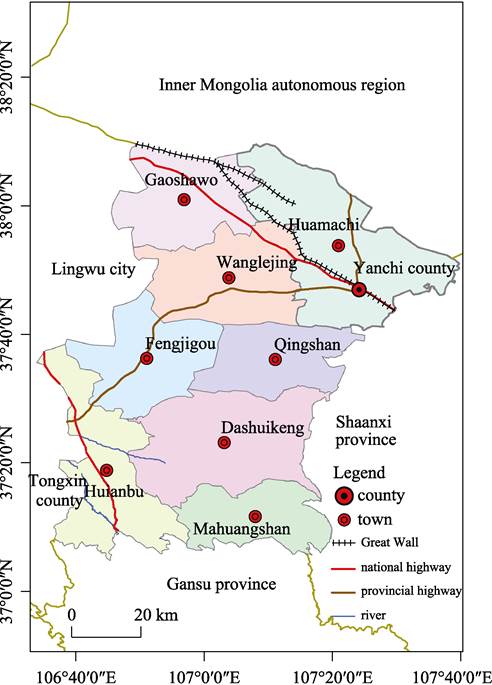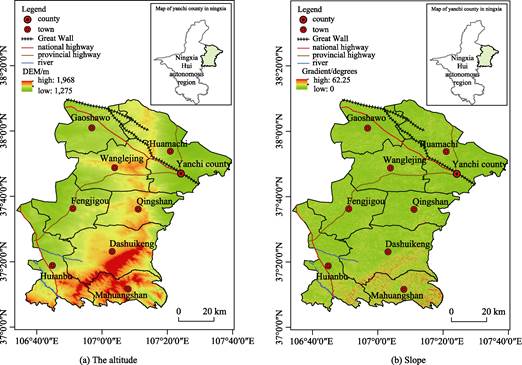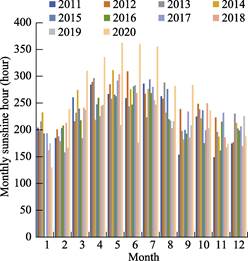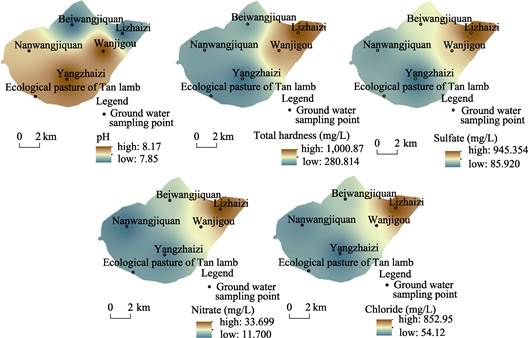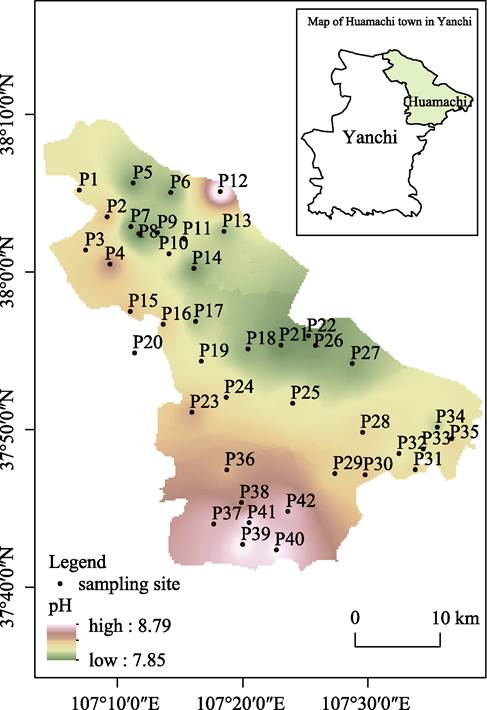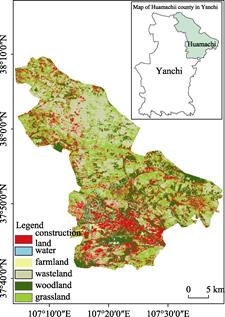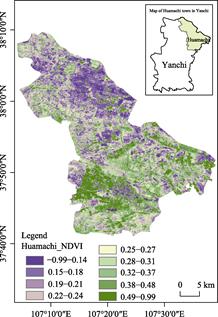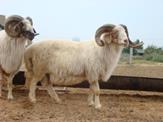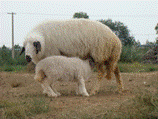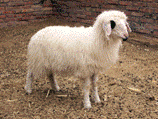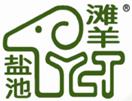Yanchi Tan Sheep Dry Grassland Case in Huamachi Township
Abstract
The Huamachi town of Yanchi county, Ningxia Hui autonomous region of China is located at the border among four provinces (Shaanxi, Gansu, Inner Mongolia and Ningxia) and is mainly covered with arid grassland. Yanchi Tan sheep is the National Geographical Indication Product, which plays an irreplaceable role in the life of local people in Yanchi, Ningxia Hui autonomous region. Huamachi town is the core habitat (ecological geographical environment) of Yanchi Tan sheep, which has accumulated the experience of inheritance significance in the habitat protection and sustainable development of Tan sheep. The case dataset of Tan sheep of semi-arid grassland in Huamachi town of Yanchi includes: (1) The dataset of Huamachi town of Yanchi and its adjacent areas; (2) DEM and slope classification data of Yanchi county; (3) Soil pH and chemicals in Wanjigou village, Huamachi town, Yanchi county; (4) Yanchi grassland plant species data; (5) Groundwater chemical data of Wanjigou village, Huamachi town; (6) Land use and NDVI data of Yanchi county. The dataset is archived in .shp, .tif, .xls, .png and .docx formats with a data size of 329 MB (211 MB in compressed) and consists of 74 data files.
Introduction
Yanchi county is located in the east of Ningxia, at the border of Shaanxi, Gansu, Inner Mongolia and Ningxia and is within 106°33′E-107°47′E and 37°04′N-38°10′N. The ancestor of Yanchi Tan sheep is the Mongolia sheep, one of the three sheep breeds in China. After years of natural evolution and artificial breeding, it has developed its unique features[1]. To preserve Yanchi Tan sheep, various measures have been taken, including national standard[2] in 1980, national geographical indication protection in 2016[3], and local standard in 2020[4]. “Yanchi Tan sheep Huamachi town arid grassland case dataset on ecosystem protection and sustainable development”[5] is a new effort and may be used to study the habitat sustainability.
Metadata of the Dataset
The metadata of the dataset[5] is summarized in Table 1. It includes the full name, short name, authors, geographical region, year of the dataset, data format, data size, data files, foundation, data publisher, address and data sharing policy, etc.
Table 1 Metadata summary of the dataset
| Items | Description |
|---|---|
| Dataset full name | Yanchi Tan sheep Huamachi town arid grassland case dataset on ecosystem protection and sustainable development |
| Dataset short name | YanchiTanSheepCase01 |
| Authors | Zhang, M. X. L-8674-2018, Ningxia University, 1014279339@qq.com |
| Sun, Y. W., Agriculture and Rural Affairs Bureau of Yanchi County, 2321858709@qq.com Li, B., Ningxia Yanchi Tanyang Industry Group, Yanchi, Ningxia, 411702569@qq.com Liu, C. L-3684-2016, Institute of Geographic Sciences and Natural Resources Research, CAS, lchuang@igsnrr.ac.cn Wu, G. H., Ningxia YanchiTanyang Industry Group, Yanchi, Ningxia, 911844543@qq.com Wang, Y. J. AAO-8514-2021, Ningxia University, wyj8690@163.com Yan, R., Ningxia University Wang, Z. X., Institute of Geographic Sciences and Natural Resources Research, CAS, wangzx@igsnrr.ac.cn Shi, R. X., Institute of Geographic Sciences and Natural Resources Research, CAS, shirx@igsnrr.ac.cn Yu, X. H., Publicity Department of Ningxia Bai, Y. J., Wanjigou Village, Huamachi Town, Yanchi County, Ningxia | |
| Geographical region | Yanchi county, Ningxia, 106°33′55.8″E-107°39′42.1″E; 37°4′49.7″N-38°9′44.6″N |
| Year | 2020 Data format .shp, .xls, .tif, .png, .docx |
| Data size | 329 MB (212 MB after compression) |
| Data files | (1) boundary data of Yanchi county, township and village; (2) DEM and slope data of Yanchi county; (3) grassland data in Wanjigou village, Huamachi town; (4) grass types list, Yanchi; (5) groundwater pH and chemicals, Wanjigou village, Huamachi town; (6) land use and NDVI, Yanchi county |
| Foundations | Ningxia Natural Science Foundation of China (2020AAC03114); High Quality Development Project of Tan Sheep in Yanchi County; Chinese Academy of Sciences (A99P2010YT) |
| Data publisher | Global Change Research Data Publishing & Repository, http://www.geodoi.ac.cn |
| Address | No. 11A, Datun Road, Chaoyang District, Beijing 100101, China |
| Data sharing policy | Data from the Global Change Research Data Publishing & Repository includes metadata, datasets (in the Digital Journal of Global Change Data Repository), and publications (in the Journal of Global Change Data & Discovery). Data sharing policy includes: (1) Data are openly available and can be free downloaded via the Internet; (2) End users are encouraged to use Data subject to citation; (3) Users, who are by definition also value-added service providers, are welcome to redistribute Data subject to written permission from the GCdataPR Editorial Office and the issuance of a Data redistribution license; and (4) If Data are used to compile new datasets, the ‘ten per cent principal’ should be followed such that Data records utilized should not surpass 10% of the new dataset contents, while sources should be clearly noted in suitable places in the new dataset[6] |
| Communication and searchable system | DOI, CSTR, Crossref, DCI, CSCD, CNKI, SciEngine, WDS/ISC, GEOSS |
DOI: https://doi.org/10.3974/geodp.2021.03.04
CSTR:https://cstr.escience.org.cn/CSTR:20146.14.2021.03.04
Dataset Availability Statement:The dataset supporting this paper was published and is accessible through the Digital Journal of Global Change Data Repository at: https://doi.org/10.3974/geodb.2021.05.09.V1 or https://cstr.escience.org.cn/CSTR:20146.11.2021.05.09.V1
Geographical Boundary Data of the Study Area
The boundary data of this study include geographic data of Yanchi county and Huamachi town. This county covers an area of 8,522 km2 including 4 towns, 4 townships, and one street office. Four towns are: Huamachi, Dashuikeng, Huianbao, and Gaoshawo. Four townships: Wanglejing, Fengjiegou, Qingshan, Mahuangshan. Huamachi town is located in the northeast corner of Yanchi, is the capital of Yanchi county. The town covers an area of 1,531 km2, including 23 administrative villages, one urban community and 146 natural villages. Of the 35,000 residents, there are 32,000 working in agriculture sector (Figure 1).
Geographical Data
The geographical data includes DEM and slope, meteorological data, hydrology data, soil data, land cover data, and grassland data. Terrain and Meteorological Data
Yanchi county lies in the transitional zone from the Loess plateau in the south to the Maowusu desert in the north (Figure 2). As a result, the corresponding climate is a transition from semiarid to arid, the vegetation is the transition from arid grassland to desert, and the land use is the transition from agriculture to pasture[7]. This transition in geography leads to the diversity of natural resources and the fragility of ecological environment.
The climate of Yanchi is continental arid, with four distinct seasons, late spring and early autumn, long winter and short summer, sufficient sunshine and intense evaporation. According to the records of Yanchi Meteorological Station (2011-2020), the annual average temperature of Yanchi is 7.8 °C, the extreme high temperature is 38.1 °C and the extreme low temperature is ‒29.6 °C, and the day-night temperature difference can reach 20 °C. The annual sunshine is 2,180-3,390 hours. The annual rainfall is 200-240 mm, mostly concentrated in July, August and September, accounting for more than 60% of the annual precipitation. The annual evaporation is about 1,800-2,400 mm, and is about 10 times of the annual precipitation. The monthly precipitation, monthly average temperature and monthly sunshine duration in Yanchi from 2011 to 2020 are shown in Figure 3, 4 and 5.
| Figure 3 Monthly precipitation in Yanchi, 2011-2020 | Figure 4 Monthly average temperature in Yanchi, 2011-2020 |
|---|---|
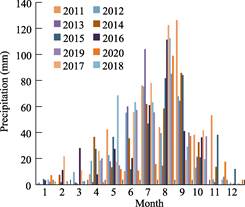 |
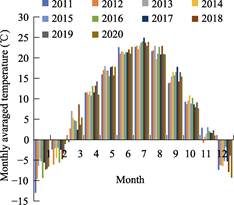 |
Groundwater Quality Data
Groundwater Quality Data
Six water quality samplings were conducted in five villages (Nanwangjiquan, Beiwangjiquan, Lizhaizi, Wanjigou, and Yangzhaizi villages) and one ecological pasture of Tan Sheep Group Company. Water quality analysis was completed by the water quality Testing Center of Ningxia ShuitouYanchi Water Co., Ltd., (Table 2, and Figure 6).
As can be seen from Table 2, groundwater in the whole region is generally alkaline, with pH value between 7.85 and 8.17, and the most alkaline places are located in Yangzhaizi and Wanjigou. The highest groundwater hardness is located in Lizhaizi, which is 1,000.9 mg/L, belongs to the extra-hard water.
Quality of Water Consumed by Tan Sheep in Wanjigou
According to the National standard for groundwater quality (GB/T 14848—2017)[8] and the comparative analysis of toxicological indicators of groundwater in the case area, the fluoride
in five samples (No.2-No.6) exceeded the standard, the toxicological indicators of the groundwater samples met the Class III water standard. GB 5749—2006 stipulates that Class III groundwater is medium in quality, suitable for centralized drinking water, industrial and agricultural water; and Class IV groundwater is poor, which is only suitable for agriculture and some industry, and cannot be used as drinking water without proper treatment (Table 3).
Table 2 Sensory characteristics and general chemical indexes of groundwater (mg/L)
| No. | Sampling point | pH | Soluble total solids | CaCO3 | Ammonia nitrogen | Fe | Mn | Cu | Zn | Chloride | Sulfate |
|---|---|---|---|---|---|---|---|---|---|---|---|
| 1 | Nanwangjiquan | 8.05 | 989 | 400.4 | 0.056 | <0.003 | <0.008 | <0.003 | <0.015 | 130.6 | 222.1 |
| 2 | Beiwangjiquan | 7.85 | 1,740 | 420.4 | 0.086 | <0.003 | <0.008 | <0.003 | <0.015 | 322.1 | 480 |
| 3 | Lizhaizi | 7.85 | 3,356 | 1,000.9 | 0.619 | <0.003 | <0.008 | <0.003 | <0.015 | 853 | 945.4 |
| 4 | Wanjigou | 8.17 | 2,320 | 820.7 | 0.218 | <0.003 | <0.008 | <0.003 | <0.015 | 438.2 | 580.7 |
| 5 | Yangzhaizi | 8.17 | 518 | 280.8 | 0.179 | <0.003 | <0.008 | <0.003 | <0.015 | 54.1 | 85.9 |
| 6 | Eco Pasture | 8.1 | 1,058 | 340.3 | 0.048 | <0.003 | <0.008 | <0.003 | <0.015 | 210.4 | 290.1 |
Table 3 Toxicological indexes of groundwater in sampling points (mg/L)
| No. | Sampling point | As | Cd | Cr | Pb | Hg | Se | fluoride | Nitrate (N) |
|---|---|---|---|---|---|---|---|---|---|
| 1 | Nanwangjiquan | <0.001 | <0.000,25 | <0.004 | <0.000,20 | <0.000,1 | <0.000,4 | 3.82 | 11.7 |
| 2 | Beiwangjiquan | <0.001 | <0.000,25 | <0.004 | <0.000,20 | <0.000,1 | <0.000,4 | 7.13 | 19.3 |
| 3 | Lizhaizi | <0.001 | <0.000,25 | <0.004 | <0.000,20 | <0.000,1 | <0.000,4 | 6.96 | 33.7 |
| 4 | Wanjigou | <0.001 | <0.000,25 | <0.004 | <0.000,20 | <0.000,1 | <0.000,4 | 4.33 | 22.9 |
| 5 | Yangzhaizi | <0.001 | <0.000,25 | <0.004 | <0.000,20 | <0.000,1 | <0.000,4 | 1.58 | 13.1 |
| 6 | Eco Pasture | <0.001 | <0.000,25 | <0.004 | <0.000,20 | <0.000,1 | <0.000,4 | 5.13 | 15 |
Main Soil Types and pH
According to the second soil survey in Yanchi in 1983, the soil in Yanchi can be divided into nine types: lime soil, aeolian soil, dark loessial soil, saline soil, fresh soil, meadow soil, heap-bed soil, bobby soil and bare rock. In this study, 40 sample points were chosen in Huamachi, and the soils in sampling points are lime soil, saline soil and aeolian sand soil. First, GPS is used to record the geographical locations of sampling points. Second, removed about 10 cm of surface soil, and cleaned up all organic impurities in the soil, such as leaves and roots. Third, the ZD-18 instrument was used to insert the metal probe into the soil vertically and clockwise to about 8-10 cm, and the soil was compacted evenly around the probe to make the soil fully contact with the probe. After the numerical value was stabilized, the readings were recorded (Figure 7). Figure 7 shows that the soil pH in Huamachi was high in the south and low in the north.
Unique Grassland Resources
Plant Types: 173 Species from 39 Families and 118 Genera
There are four types of grassland in Yanchi, including dry steppe grassland, desert grassland, sand vegetation grassland and halophyte vegetation grassland. There are 175 species of natural plants, which belong to 39 families, and most of them are forage plants. Among them, 12 kinds of plants such as licorice and bitter beans are included in the pharmacopoeia, and 4 kinds of plants such as green bristle grass are used for folk medicine (Table 4).
Land Use and Land Cover (NDVI) in Huamachi Town
(1) Land use in Huamachi town
The land cover and land use map of Huamachi are produced based on Sentinel-2 L2A data[9]. Land use consists of six types, including construction land, water, cultivated land, woodland and grassland (Figure 8). The grassland accounted for 30.24% of the total area of Huamachi.
(2) Land cover (NDVI) in Huamachi town
Based on the Sentinel-2 data, NDVI for five-scenes from September 8, 2020 (spatial resolution of 10 m) were calculated and synthesized using Equation (1) (Figure 9).
 (1)
(1)
where NIR is the near-infrared band (Band8 in Sentinel-2); R is the red band (Band4 in Sentinel-2). The statistics show that NDVI of Huamachi in September 2020 is between 0 and 0.99, of which, NDVI above 0.21 accounts for 65.77% of the total area.
Table 4 Statistics of families, genera and species of natural plants in Yanchi
| No. | Families | No. of genera | No. of species | No. | Families | No. of genera | No. of species |
|---|---|---|---|---|---|---|---|
| 1 | Leguminosae | 18 | 33 | 21 | Euphorbiaceae | 1 | 2 |
| 2 | Gramineae | 18 | 30 | 22 | Paeoniaceae | 1 | 2 |
| 3 | Chenopodiaceae | 12 | 14 | 23 | Solanaceae | 1 | 1 |
| 4 | Compositae | 10 | 20 | 24 | Rutaceae | 1 | 1 |
| 5 | Rosaceae | 6 | 11 | 25 | Violaceae | 1 | 1 |
| 6 | Caryophyllaceae | 4 | 4 | 26 | Oleaceae | 1 | 1 |
| 7 | Ranunculaceae | 4 | 4 | 27 | Verbenaceae | 1 | 1 |
| 8 | Papaveraceae | 4 | 4 | 28 | Sapindaceae | 1 | 1 |
| 9 | Cruciferae | 4 | 4 | 29 | Arnebiaceae | 1 | 1 |
| 10 | Zygophyllaceae | 3 | 4 | 30 | Tamaricaceae | 1 | 1 |
| 11 | Polygonaceae | 2 | 4 | 31 | Polygalaceae | 1 | 1 |
| 12 | Cyperaceae | 2 | 2 | 32 | Rhamnaceae | 1 | 1 |
| 13 | Labiatae | 2 | 2 | 33 | Oxalidae | 1 | 1 |
| 14 | Convolvulaceae | 2 | 2 | 34 | Pedaliaceae | 1 | 1 |
| 15 | Scrophulariaceae | 2 | 2 | 35 | Loniceraceae | 1 | 1 |
| 16 | Crassulaceae | 2 | 2 | 36 | Campanulaceae | 1 | 1 |
| 17 | Liliaceae | 1 | 3 | 37 | Amaranthaceae | 1 | 1 |
| 18 | Ephedracaea | 1 | 3 | 38 | Moraceae | 1 | 1 |
| 19 | Asclepiadaceae | 1 | 2 | 39 | Santalaceae | 1 | 1 |
| 20 | Iridaceae | 1 | 2 | ||||
| Total | 39 | 118 | 173 |
Variety Data of Yanchi Tan Sheep
Identification (Authentication) Standard of Yanchi Tan Sheep
Yanchi Tan sheep is a breed for both its skin and meat products, and the identification of this breed has been included in national and local standards. According to the national standard GB/T 2033—2008 and the local standard geographical indications of Ningxia Hui autonomous region—Yanchi Tan sheep DB64/T 1545—2020[4], Yanchi Tan sheep has a medium build, strong constitution, good combination of all parts of the body, slightly raised nose bridge, and with three kinds of ears: large, medium and small. Rams have spiral horns extending outward; ewes are usually have no or small horns. The back waist is straight, the chest is deeper, the limbs are straight and the hooves are solid. The tail root is wide, the tail tip is fine and round, and it is inverted long triangle and droops over the hock. Body hair color is pure white, most of the head have brown, black, or yellow hair spots (Figure 10).
| Figure 10 Yanchi Tan Sheep: Rams, Ewes and 35–45 days old lambs |
|---|
According to the former State Administration of Quality Supervision, Inspection and Quarantine, the Genaral Administrtion of Quality Supervision, Inspeiction and Quarantine of P. R. China, the protected area of the geographical indication product is limited to the administrative department of eight towns in Yanchi county within the administrative area (Figure 1).
The Mutton Product Standards of Yanchi Tan Sheep
The quality of mutton product from Yanchi Tan sheep is guaranteed by a series of specifications and standards. Specifically, items 15-27 in Table 5 cover a wide range of fields regarding mutton quality, from carcass classification to product delivery.
Product Standards of Tan Sheep Fur and Fur of Lambs
Because of its soft texture and light and strong leather board, the leather of Tan sheep is the best material for making leather clothes and leather goods. The fur of lambs is produced about one month after birth (35-45 days), and the length of the wool strand reaches 7-8 cm. The release standard and the fur products of Tan sheep have been listed as the local standard of Ningxia Hui autonomous region (DB64/T 687—2011). The fur of lambs has strict localities as Tan sheep (item 28 in Table 5).
Social Infrastructure for Yanchi Tan Sheep Development
The total population in Yanchi is about 159,200, with 81,822 living in towns and 77,303 in villages. There are 4,500 Hui minorities, accounting for 2.6 percent of the county’s population. In 2020, the per capita disposable income of farmers is 13,922 Yuan, more than 50% comes from the tan sheep industry. The government, enterprises, herdsmen, technology and media in Yanchi have coordinated to protect the habitat of Yanchi Tan sheep using following measures.
Preservation of Fine Varieties
Yanchi is the home to Tan sheep in China. For a long time, Yanchi Tan sheep is closely related to local people’s life, and forms the only germplasm resources. It is the consensus of all stakeholders in Yanchi to protect the fine quality of Tan sheep. From June 8 to 10, 2020, President XI Jinping inspected Ningxia, and made comment about Tan sheep, “Tan sheep has good quality and has its own special flavor, and we should get it well preserved.”.
Protection of Intellectual Property
Geographical indication products are a kind of intellectual property. Yanchi Tan sheep has registered geographical indication products and are also the precious intellectual property of Yanchi people. The government and enterprises of Yanchi attach equal importance to the protection of intellectual property and product quality. Specific measures include:
(1) Raising the awareness of intellectual property rights, registered the trademarks of geographical indication
In 2005, “Yanchi Tan sheep” (Class 29, registration number: 3334050) was registered by the State of Trademark Administration as a certification trademark of geographical indications to prove the specific quality and origin of “Yanchi Tan Sheep”. In 2008, the Ministry of Agriculture awarded Yanchi Tan sheep “Agricultural Geographical Products”; In 2016, the General Administration of Quality Supervision, Inspection and Quarantine awarded Yanchi Tan sheep “National Geographical Indications Protection Product”. Thus, Yanchi Tan sheep has the exclusive trademark right under legal protection (Figure 11).
(2) Implementation of the Trademark of Geographical Indication Products of Yanchi Tan Sheep
In 2021, the government of Yanchi issued measures to administrate the Trademark of geographical indications products of Yanchi Tan sheep. The measures stated clearly that “Yanchi Tan Sheep” is a collective Trademark of Geographical Indications Products, whoever wants to use this trademark need to apply for it, get the approval from trademark registrant, and sign the trademark use contract. Without the permission of the trademark registrant, no organization or individuals may use it.
(3) Inspection of law enforcement to protect the exclusive right of “Yanchi Tan Sheep” trademark.
Governments at all levels in Ningxia carried out rectification actions on the use of the registered trademark of “Yanchi Tan Sheep”, and banned the actions of deceiving consumers by illegally using the geographical indications of “Yanchi Tan Sheep”. The intellectual property rights of trademark registrants and the legitimate rights and interests of consumers of “Yanchi Tan Sheep” will be effectively safeguarded.
Standardization of Management
A series of standards have been issued for the geographical indication products of Yanchi Tan sheep. The standardization of Yanchi Tan sheep management is an important guarantee for the protection of Yanchi sheep species, ecological and geographical environment, and the interests of herdsmen. The 28 standard and technical Specifications of the “Yanchi Tan Sheep” production are listed in Table 5.
The Government Provided Ecological Compensation for Grassland Protection
To restore high-quality pastures, the government has issued a grazing ban policy. In 2020, 95,964 ha of grassland received ecological compensation in Huamachi town. Yanchi county provided the ecological compensation of 112.5 Yuan/ha to implement the forbidding grazing policy, 10.8 million Yuan in total and benefiting 8,573 herdsmen.
Roles Played by Enterprises
Ningxia Yanchi Tan Sheep Industry Development Group Co., Ltd. is a wholly state-owned enterprise established by the government of Yanchi county in 2017. It is an industrial enterprise of Tan sheep and serves multiple functions: preservation, purchase, processing, storage, sales and promotion of Yanchi Tan sheep. At present, the company has a slaughtering factory with a capacity of 300,000, and has 5,000 sheep in the ecological pastures. In addition, the company facilitates scientific research, establishes species germplasm bank, help to diminish various risks. To protect Yanchi Tan sheep species and its genetic germplasm resources, Ningxia Yanchi Tan Sheep Industry Group Co., Ltd. established series of measures, a demonstration farm, and a monitoring system.
Demonstration of new technology and management is an integral part of the Ningxia Yanchi Tan Sheep Industry Development Group, which covers wide areas. Meet the volatile market resulted from various factors is another challenge. For example, in 2019, the company gave each sheep a subsidy of 30 Yuan to enhance farmers’ capacity to meet the unstable market, with a total subsidy of more than 6 million Yuan (Table 6). During COVID -19 outbreaks in 2020, the company set up a trading service platform to help farmers sell their sheep at a fare price, and meanwhile help farmers buy small lamp.
Table 5 Standard and Technical Specifications of Yanchi Tan Sheep Management
* NS= National standard; LS=Local standard (Ningxia).
Table 6 Subsidy from Ningxia Yanchi Tan sheep industrial development group in 2019
| Batch | Towns | Villages | Natural village | Subsidy number | Subsidy standard (Yuan/Sheep) | Subsidy amount (Yuan) |
|---|---|---|---|---|---|---|
| 1 | 8 | 74 | 213 | 51,246 | 30 | 1,537,380 |
| 2 | 8 | 52 | 161 | 23,564 | 30 | 706,920 |
| 3 | 8 | 61 | 189 | 21,854 | 30 | 655,620 |
| 4 | 8 | 70 | 206 | 23,009 | 30 | 690,270 |
| 5 | 8 | 35 | 68 | 6,921 | 30 | 207,630 |
| 6 | 8 | 85 | 241 | 73,243 | 30 | 2,197,290 |
| 7 | 8 | 32 | 103 | 21,396 | 30 | 641,880 |
| Total | 409 | 1,181 | 221,233 | 6,636,990 |
Summary
Persistence of “Yanchi Tan Sheep” as a national geographic indication product benefits from two factors: the unique, irreplaceable ecological environment (habitat) in Yanchi, and the well-developed social infrastructure—the engagement of all stakeholders from individual farmers to relevant companies to local governments. The development of “Yanchi Tan sheep Huamachi town arid grassland case dataset on ecosystem protection and sustainable development” is a new effort in this direction. This dataset will promote Yanchi Tan sheep industry in Ningxia to develop in terms of more scientific approach, more efficient management, more delicious and safer products. The key takeaways from the development of this case dataset is: development must adapt to local conditions; respect geographical tradition; the integration of variety, quality, brand promotion and reputation; the integration of herdsmen, enterprises, government, academics; and the coordination of information flow, logistics, and people flow. While Yanchi Tan sheep has its unique feature, it is also a section in a broader spectrum of worldwide geographic indication sheep product[10]. There are still many issues to be solved, such as the relationship between water, soil, grass and air and the quality of Yanchi Tan sheep, and the breed protection and quality inheritance of Yanchi Tan sheep.
References
[1] Liang, Y., Min, Q. W. Study on the conservation and utilization of the important agricultural heritage systems in Ningxia [J]. Study on Natural and Cultural Heritage, 2019, 4(11): 96‒100.
[2] General Administration of Quality Supervision, Inspection and Quarantine of P. R. China; China National Standardization Administration Committee. Tan sheep (GB/T 2033—2008) [S].
[3] Local standards of Ningxia Hui autonomous region. Geographical indication product, Yanchi Tan sheep (DB64/T 1545—2020) [S]. 2020.
[4] General Administration of Quality Supervision, Inspection and Quarantine of P. R. China. Announcement on approving the protection of geographical indication products for Gannan tea oil and other products (No. 9, 2016) [OL]. https://dlbzsl.hizhuanli.cn:8888/Product/Detail/468.
[5] Zhang, M. X., Sun, Y. W., Li, B., et al. Yanchi Tan sheep Huamachi town arid grassland case dataset on ecosystem protection and sustainable development [J/DB/OL]. Digital Journal of Global Change Data Repository, 2021. https://doi.org/10.3974/geodb.2021.05.09.V1. https://cstr.escience.org.cn/CSTR:20146.11.2021.05.09.V1.
[6] GCdataPR Editorial Office. GCdataPR data sharing policy [OL]. https://doi.org/10.3974/dp.policy.2014.05 (Updated 2017).
[7] Zhang, K. B., Li, R., Hou, R. P., et al. Study on plant diversity of different control measures of desertification in Yanchi county, Ningxia [J]. Science of Water and Soil Conservation, 2004(4): 66-72.
[8] General Administration of Quality Supervision, Inspection and Quarantine of P. R. China; China National Standardization Administration Committee. Standard of groundwater quality (GB/T 14848—2017) [S]. Beijing: Standards Press of China, 2017.
[9] EU Copernicus Programme, Sentinel-2 L2A data website [DB/OL]. https://scihub.copernicus.eu/dhus/#/home.
[10] Erasmus, S. W., Muller, M., Hoffman, L. C. Authentic sheep meat in the European Union: factors influencing and validating its unique meat quality [J]. Journal of the Science of Food and Agriculture, 2017, 97(7): 1979.
Case Team
Principle Investigator
Principle Investigator Zhang Mingxin
Zhang Mingxin, Male, born in May 1980, from Tongxin, Ningxia, with a Ph.D., associate professor, and master's degree supervisor; Mainly engaged in teaching in geographic information systems and research on regional environmental health and sustainable development, and led the completion of one National Natural Science Foundation project; Three projects funded by Ningxia Natural Science Foundation. Mainly responsible for teaching courses such as Professional English, Land Use Planning, and Cartography for undergraduate students majoring in Geographic Information Science, as well as teaching courses such as Geographic Information System Applications for graduate students.Published two academic works as the first author and edited one professional course textbook as the chief editor; Published 20 academic papers in core journals. From 2018 to present, served as the Deputy Secretary General of Ningxia Geographical Society, responsible for the daily business work of Ningxia Geographical Society; Simultaneously serving as the Director of the Youth Professional Committee of Ningxia Geographical Society. During the period from 2020 to 2021, he participated in the "Geographical Indications Environment & Sustainability" of the Chinese Academy of Sciences, and completed the country's first high-quality geographical product habitat protection and sustainable development plan case: Yanchi Tan Sheep Huamachi Town Arid Grassland Case, which was published on the front page of the third issue of the fifth volume of the Journal of Global Change Data&Discovery.
Expert members of the case team
Sun Yongwu,Senior Animal Husbandry Specialist, Agriculture and Rural Affairs Bureau of Yanchi.
Li Bo, Vice General Manager, Yanchi Tan Sheep Group of Ningxia.
Liu Chuang, Professor, Institute of Geographic Sciences and Natural Resources Research, Chinese Academy of Sciences
Wu Genghong, Sales manager, Yanchi Tan Sheep Group of Ningxia.
Wang Yingjing, Graduate student, School of Geography and Planning, Ningxia University.
Yan Rui, lecturer, College of Agriculture, Ningxia University.
Wang Zhengxing, Associate Professor, Institute of Geographic Sciences and Natural Resources Research, Chinese Academy of Sciences.
Shi Ruixiang, Deputy editor, Institute of Geographic Sciences and Natural Resources Research, Chinese Academy of Sciences.
Bai Yunjiang, Village branch secretary, Wanjigou Village, Huamachi Town,Yanchi County.
Author Contributions
Liu, C. and Yu, X. H. made the overall design of the original ecological environment protection and sustainable development case study of Yanchi Tan sheep in Huamachi town, Yanchi county, and hosted a field seminar on the case in January 2021.Yu, X. H., Sun, Y. W., Li, B., Wu, G. H., Liu, C. and Zhang, M. X. completed the field investigation, and Zhang, M. X. designed the data set framework; Wang, Y. J., Zhang, M. X. developed the land use data. Sun, Y. W., Li, B., Wu, G. H. and Zhang, M. X. analyzed water, plants, and soil data, Wang, Z. X. provided data processing technology and Shi, R. X. classified elevation data, Shi, R. X. finalized the dataset, Wang, Y. J. processed data and completed the thesis draft, Liu, C. adjusted the data structure and data results, revised the Chinese version of the data paper, Wang, Y. J. and Zhang, M. X. translated the paper into English, and Liu, C. and Wang, Z. X. proofed the English version.
Acknowledgements
The team members who assisted in the field investigation are: Ma, R. Y., Minister of Yanchi Publicity Department; Li, R., Deputy Minister of Yanchi Publicity Department; Jin, J. R., chairman of Ningxia Tan Sheep Group, Li, Y. L., Deputy General Manager of Ningxia Tan Sheep Group; Zhang, H. M., Institute of Space and Space Information Innovation, CAS; Yan, S., Project Assistant of Key Laboratory of Resource Utilization and Environmental Restoration, Institute of Geographic Sciences and Natural Resources Research, CAS.
